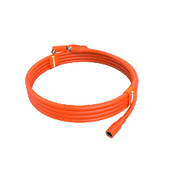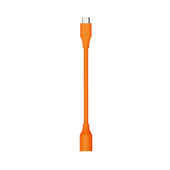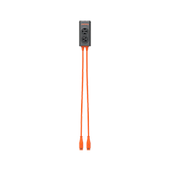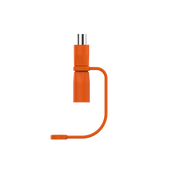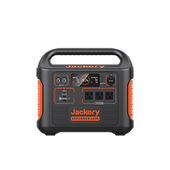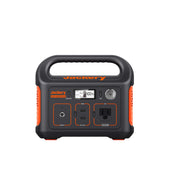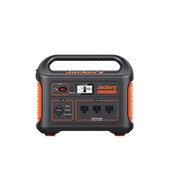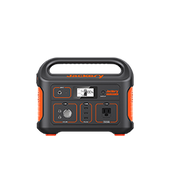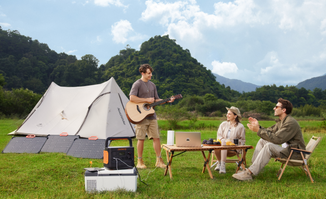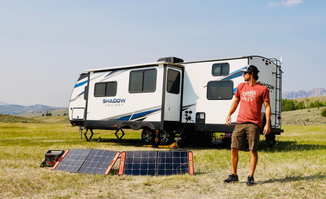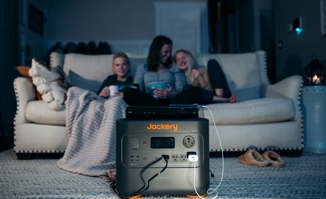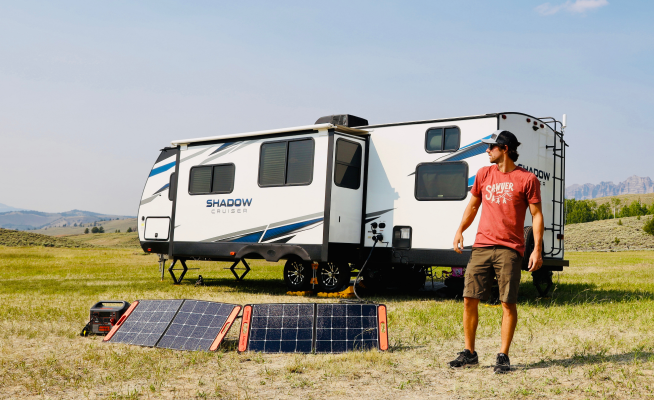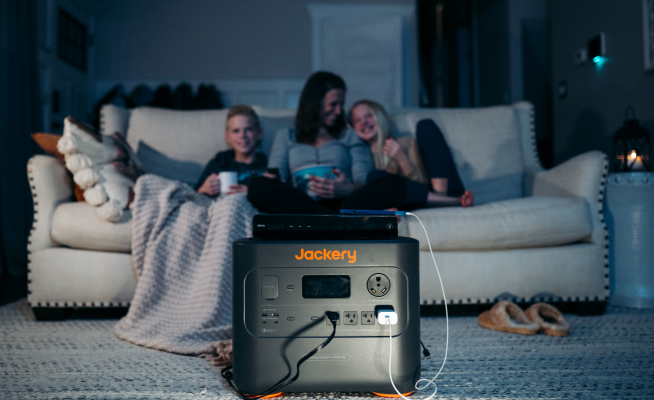The Ultimate Guide to What Is a Power Bank and How It Works
Running out of battery can be a huge concern, especially when you might not have access to a wall outlet or other electricity points to charge your phone or other gadgets. But, thanks to portable power banks, you may charge smartphones and tablets without worrying about electricity. But what is a power bank? How does it work, and how to choose one?
A solar power bank is a life-saver to charge small appliances when you're away from electricity. Whether planning to go on an office trip or a family camping, the Jackery portable power banks are the most appropriate choice for your on-to-go power requirements.

If you intend to buy a portable power bank to keep all gear charged, this article will help you out. Here we'll walk you through the basics of a power bank, its types, working, and the considerations to choose the best one.
What Is A Power Bank?
Let's start with what is a power bank.
A power bank (a portable battery or charger) is a backup accessory to power your small electronic appliances without worrying about running out of electricity.
It lets you charge the battery-powered devices when the included battery dies. It can be compact enough to fit in your pocket or big enough to power a wide range of appliances.

With a power bank, you can seamlessly charge cell phones, tablets, laptops, etc., depending on its capacity and efficiency. You can connect the rechargeable battery to your smartphone using a USB cable.
What Is A Power Bank Used For?
The purpose of a portable power bank is to charge mobile devices, smartwatches, and sometimes even laptops. You can charge the power bank using a USB charger. Once fully charged, you can connect it to your devices.
Many power banks come with multiple input/output charging ports, so you can charge multiple devices simultaneously.
What Are The Benefits Of A Power Bank?
Having a power bank means accessing a safe, reliable, and portable form of energy. Now that we have discussed power banks and 'what is a power bank used for,' it's time to understand the benefits it brings along.
- Portable:Most power banks are portable, making them an easy-to-transport option for your trips. People who love camping, hiking, and other outdoor activities can leverage the mobile nature of power banks and charge all their devices without using fuel or other toxic elements.
- Affordable: Quality power banks won't cost you an arm and a leg. Many portable power chargers will cost you a few dollars and power your smartphones whenever you need them.
- Fast-Charging: Power banks provide fast charging on the go instead of finding a wall outlet or access to an electric socket.
- Customizable: Power banks come in various designs, sizes, shapes, and types. That said, you can analyze the features of power banks and choose the one that fits your needs. You can use small power stations if you want to charge only smartphones. Alternatively, if you intend to power different devices at once, consider choosing a high-capacity power bank.
- Reusable: Each time you plan for camping, hiking, outdoor adventure, RV trip, or office trip, you can carry the same power charger with you. Depending on the power bank's brand, efficiency, and capacity, each comes with different charging cycles. Thus, you can recharge and reuse the power bank again and again.
- No Worry About Low Battery:No matter where you go, having a power bank ensures that you don't have to stress about a low battery ever again. You can keep your gear charged with a power bank.
The Types Of Power Banks
Different types of power banks are available, including solar power banks, universal power banks, wireless power banks, etc.
- Solar Power Bank
As the name suggests, the solar power bank relies on solar energy to charge the appliance. They consist of photovoltaic panels, an internal battery, and input/output ports that work together to power appliances. This is an excellent charging option, especially where you're away from the primary power source. The best part about solar power banks is that they are a renewable energy source. Teaming them with solar panels can help you convert sunlight into electricity, which transfers to the device.
- Universal Power Bank
These portable power banks can be charged using standard USB sources such as USB chargers. Different sizes and configurations of universal power banks feature AC outlets, USB ports, etc.
- Wireless Power Bank
They use Qi standard charging methods to power electronic devices wirelessly. First, the device to be charged is placed on the power bank (you can refer to the instructions on placement), and then the button is pressed to transfer the charge from the power bank to the device.
How Does A Power Bank Work?
If you're thinking of buying a portable charging source like a power bank, you might have come across the question: what is a power bank, and how does it work? As we have covered the basics of a power bank, it's time to unveil how it works.

Power banks work on a simple mechanism that includes source, storage, and usage. The power source charges the built-in battery, which transfers the current to the electrical device.
Most power banks come with an in-built battery that can be charged through an external power supply, such as a wall socket (AC power), car charger, solar panels (if it's a solar power bank), etc.
The energy generated by the power source is stored in the portable battery to power up compatible appliances. The battery sends the stored electrical energy to the connected device using the output port.
How To Charge A Power Bank?
Since most power banks come with an instruction manual, charging them is pretty simple. We have elaborated on the step-by-step process of charging a power bank if you are still unsure.
Step 1: Attach Cable To Power Bank
Power banks come with USB cables that help in their charging. You can connect the cable to the Micro USB of your power bank.
Step 2: Connect the Other Side With the Power Source
The standard USB (or another side of the power cable) must be plugged into the wall plug or computer. However, if you're using a solar power generator, you may have to connect the cable to the solar panels.
Step 3: Unplug & Charge the Devices
Once the in-built battery is fully charged, you can unplug the power bank from the power source and charge your electrical appliances.
You can never go wrong with solar power generators if you're looking for the easiest way to charge appliances. They capture solar energy, transfer it to electrical energy, and power your phone or other gadgets. You can charge the solar power generator using the solar panels linked with a battery pack.
How Long Does A Power Bank Last?
The time a power bank lasts highly depends on the brand, capacity, battery, etc. But, on average, a portable power bank should last at least a few hundred charging cycles.
Power Efficiency & Power Capacity
Power efficiency and power capacity are often used interchangeably; however, they are different from each other.
Power efficiency is the ratio between a device's useful energy output and input energy. That said, a power bank with a high power efficiency can convert more received energy into usable energy.
On the other hand, power capacity refers to the storage capacity of the power bank. It is measured in milliamp-hour (mAh) and determines how much charge a power bank can hold and how many times it can charge a device before depletion.
When choosing a power bank, it's essential to consider power capacity and efficiency. This is because a power bank with high efficiency but lower capacity may not be as helpful as one with lower efficiency but higher capacity.
Here is how to calculate power capacity:
Power capacity (mAh) = Current (mA) * Time (hour)
Suppose the power bank has a current of 1000 mA and can supply power for 10 hours; its power capacity will be 1000 mA * 10 H = 10,000 mAh.
Note: This is a theoretical calculation. The practical power efficiency will be the same or less than 10,000 mAh, depending on external factors such as temperature and battery charge/discharge.
Low To High Capacity Power Banks
When buying portable charging sources, it's vital to ask: what is a good capacity for a power bank? However, with different sizes and capacities of power banks available, it's pretty challenging to choose the best one.
Below we've covered the popular low to high-capacity power banks in detail.
- Low Capacity Power Bank
Buyers wanting an occasional power source for their smartphones can choose low-capacity power banks. Anything ranging from 1000-5000 mAh is considered a low-capacity power bank. These are the most compact power banks that can charge a smartphone once after full charging.
- Medium Capacity Power Bank
These power banks have a battery capacity of 7000 mAh to 20,000 mAh. These are reliable options for people looking to charge their phones multiple times a day. A medium power bank of 10,000 mAh can charge the iPhone 12 mini thrice after a full charge. On the other hand, a 20,000 mAh battery capacity can power a standard laptop, iPad Pro, etc.
- High-Capacity Power Banks
Any power bank with more than 20,000 mAh falls into this category. They can support most of your portable appliances for a day.
|
mAh |
Pixel 3 (Number of recharges) |
iPhone X (Number of recharges) |
iPad Pro (Number of recharges) |
Galaxy S4 (Number of recharges) |
JBL Flip 4 (Number of recharges) |
Asus Laptop (Number of recharges) |
MacBook Pro (Number of recharges) |
|
10,000 mAh |
2 |
2 |
0.5 |
0.5 |
2 |
1.5 |
- |
|
20,000 mAh |
4 |
4 |
1 |
1.5 |
4 |
2.5 |
- |
|
30,000 mAh |
6 |
6 |
2 |
2.5 |
6 |
4 |
- |
|
40,000 mAh |
8 |
9 |
2.5 |
3.5 |
8 |
4 |
- |
|
50,000 mAh |
10 |
11 |
3 |
4 |
10 |
7 |
1.5 |
|
75,000 mAh |
16 |
17 |
4.5 |
6.5 |
15 |
10 |
2 |
What Is The Best Capacity Of A Power Bank?
The best capacity of a power bank depends on your needs. Before finalizing the power bank, you must understand the charging requirements of the electrical device you need to power. For instance, if you want to charge a phone battery with 1500 mAh once, consider purchasing a power bank with 2200 mAh.
Alternatively, if you intend to power multiple smartphones, a standard laptop, etc., with one power bank, you should go ahead with 10,000-20,000 mAh. In simple terms, the mAh of the power bank should always be higher than the device you intend to charge. The larger your phone battery will be, the more powerful the power bank you'll need to charge it.
How To Choose A Power Bank?
Power banks are the savior when you've no access to electrical grids. Instead of scrambling to find a wall adapter and power outlet, you can plug your device into the power bank and start charging. Here are some points you'll need to consider while purchasing a power bank.
- Number of Charging Devices
First, when choosing a power bank, you might need to list the items you wish to charge. Do you want to charge only your smartphone? Or do you plan to fuel a tablet, a standard laptop, and a smartphone? The more devices you wish to power, the higher the capacity power bank you need to purchase.
- Size and Weight
Other important considerations include the size and weight of the power bank. Given that you'll carry the power bank while traveling, it should be light in weight. You must look for a high-capacity power bank that can power your electrical appliances and is easy to carry.
- Fast Charging
No matter how expensive or heavy-duty a power station you choose, it's worthless if it does not charge fast. After all, you do not want a smartphone or other small devices to stay glued to the power bank. Jackery portable power stations come with Quick charge 3.0 support and multiple output ports, ensuring your device can charge quickly.
- Power Output
The power bank's output capacity is another crucial factor you must keep in mind. You may calculate the power you need and then analyze which portable charging station would suit your needs. You can explore Jackery portable power stations that can help you charge cell phones, laptops, tablets, and other electronic devices.
The Best Solar Power Station With Jackery
Jackery portable power bank is a renewable and rechargeable battery-powered generator. The solar power generator teams up with solar panels to collect solar energy, transform it into electricity, and charge appliances.
Jackery solar generators are easy-to-use charging sources. All you need to do is connect portable power stations with solar panels and keep them under the sun to convert sunlight into electricity. Then, the inverter converts the electricity into the form that powers your devices.

Jackery provides a wide range of portable power banks to meet your needs. Below we have mentioned our three picks for you to power appliances.
Jackery Solar Generator 2000 Pro
Jackery Explorer 2000 Pro combines with SolarSaga 200W panels to charge all your small and large electrical appliances. With a high battery capacity of 2160 Wh, Jackery Solar Generator 2000 Pro can power most outdoor devices and tools, including smartphones, laptops, e-bikes, mini coolers, etc. You can fully charge the power bank using 6 SolarSaga 200W Solar Panels in 2.5 hours, while it takes only 2 hours to charge it using the AC wall outlet. With only a push button, you can access limitless power.
|
Products |
Capacity |
Dimensions |
Input & Output Ports |
Solar Charging Time |
Appliances Charging Time |
|
Jackery Explorer 2000 Pro |
2160 Wh |
15.1 x 10.5 x 12.1in (38.4x26.90 x30.75 cm)
|
4AC, 1 Carport, 3 USB, 1 USB-C, 1 QC3.0, 1 USB-A |
Takes 2.5 hours to recharge with Explorer 2000 Pro and 6x SolarSaga 200W solar panels. |
Light(13W) 100H, TV(60W) 22H, Cooler(21W) 70H, Heating Blanket(40W) 68H, Coffee Maker(1000W) 2.2H, Electric Stove(1150W) 90Min |
Jackery Solar Generator 1500
Jackery Solar Generator 1500 combines Explorer 1500 power station and SolarSaga solar panels. It features a massive 1534 Wh capacity battery that can charge 85% of your home electrical appliances. Thanks to the Solarpeak™ technology (upgraded MPPT technology), the power bank allows you to charge the battery from zero to 80% in just 4 hours.
|
Products |
Capacity |
Dimensions |
Input & Output Ports |
Solar Charging Time |
Appliances Charging Time |
|
Jackery Solar Generator 1500 |
1534 Wh
|
14 x 10.4 x 12.7 in (35.6 x 26.4 x 32.3 cm) |
3AC, 1 USB-C, 1 QC3.0, 1 USB-A, 1 CARPORT |
Takes 4 hours to recharge with Explorer 1500 and 4x SolarSaga 100W solar panels. |
Mini Cooler (60W) 21H, Ice Shaver (700W) 120 Min, Toaster (650W) 130 Min, Microwave Oven (1000W) 68 Min, Electrical Grill (900W) 75 Min, Coffee Maker (500W) 130 Min. |
Jackery Solar Generator 1000 Pro
Jackery Explorer 1000 Pro is faster and can charge fully in 1.8 hours. Thanks to its lighter body and foldable handle, the Jackery Explorer 1000 Pro is easy to transport and store. The pure sine wave inverter can supply stable power to charge appliances. Another unique feature of the solar power station is its low self-discharge rate, which allows it to last 365 days from an 80% battery level.
|
Products |
Capacity |
Dimensions |
Input & Output Ports |
Solar Charging Time |
Appliances Charging Time |
|
Jackery Solar Generator 1000 Pro |
1002Wh |
13.39 x 10.32 x 10.06 in (34 x 26.2 x 25.5cm) |
3AC, 2 USB-C, 2 PD Ports, 2 USB-A, 1 DC Carport |
Takes 1.8H to recharge with Explorer 1000 Pro and 4x SolarSaga 200W Solar Panel |
Light(13W) 60H, TV(60W) 13H, Cooler(21W) 34H, Heating Blanket(40W) 35H, Coffee Maker(1000W) 4H, Electric Stove(1150W) 40Min |
FAQs About Power Banks
Indeed, solar power banks are the best investment for people who love outdoor adventures. To ensure that you choose the best solar power bank, here are a few other things you should be aware of.
1. How do I know my power bank capacity?
Understanding how long the battery will last (battery capacity) is essential when you shop for a power bank. A simple formula that can help you comprehend which power bank capacity is suitable for your device is the ratio of the battery capacity of the power bank and the electrical device.
Suppose the power bank has 20,000 mAh; you can divide it by the mAh of your device that needs charging to calculate power bank capacity.
2. How to extend the power bank lifespan?
Power banks have average charge cycles of 300-500. There are several ways by which you can extend the power bank lifespan.
- Charge power bank when not in use:Rechargeable batteries like power banks age faster, no matter if you use them or not. But you can slow the aging process by charging it before storing it.
- Don't drop the power bank: Portable power stations consist of a battery, circuit board, and other components. That said, you should handle it with care.
- Don't expose it to high temperatures: When batteries are exposed to extreme scenarios, they lose their energy faster and pose safety threats.
3. What is mAh capacity?
mAh (or milliamp-hours) capacity measures how much charge the battery can hold. Additionally, it represents how long it can power another appliance before you need to recharge it.
What are the benefits of a solar power bank?
Jackery solar power banks convert sunlight into electricity to charge appliances. The lightweight and adaptable green generators can power anything, including but not limited to smartphones, mini-refrigerators, lights, laptops, and even electric warmers. There are many benefits to owning a solar power bank:
- Easy to Use:Unlike traditional generators, solar power banks are easy to use. The one-button operation makes Jackery solar generators a reliable power source.
- Portable: Jackery solar generators are more portable than gas or traditional solar systems. The lightweight nature and foldable handle make it an excellent choice for camping.
- Eco-Friendly: As solar power banks use sunlight to generate electricity, they provide clean energy without toxic emissions.
- Quiet:Jackery solar generators operate without any noise. Whether you're using it to power smartphones or large appliances, you don't have to worry about noise.

Final Thoughts
Investing in solar banks can make your camping, traveling, and outdoor adventures stress-free. In addition, it is a reliable power source for your smartphones, tablets, and other electronic devices.
Now that you know what is a power bank, its benefits, and how it works, it's time to choose the right solar generator.
Jackery Solar Generator combines Explorer power station and SolarSaga solar panels that power all your gear. As sunlight is a clean and reliable energy source, you can never run out of power with a solar power bank.
Sign up for Jackery's newsletter to stay updated with product deals, exclusive discounts, and how-to guides.
Disclaimer:
The runtime mentioned for appliances powered by Jackery is for reference only. Actual runtime may vary under different conditions. Please refer to real-world performance for accurate results.






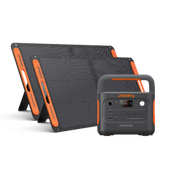


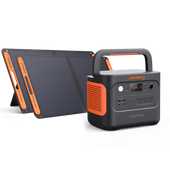

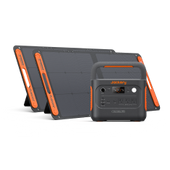
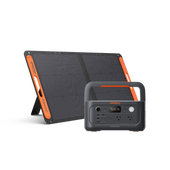
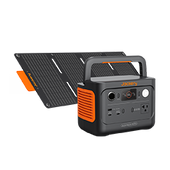
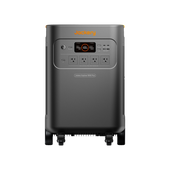
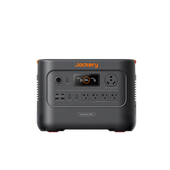
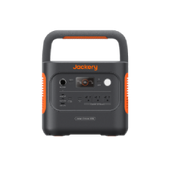
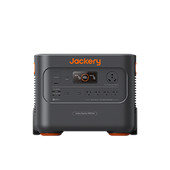
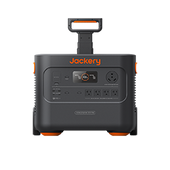

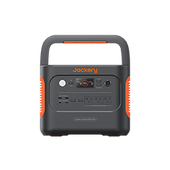
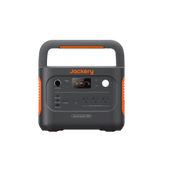
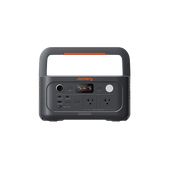

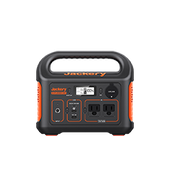
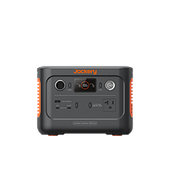
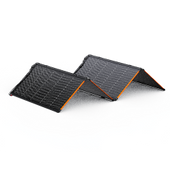
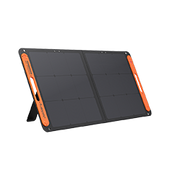

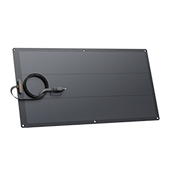
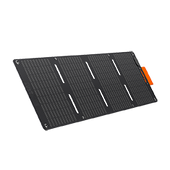
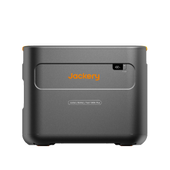
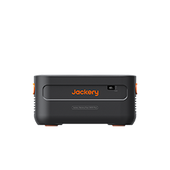
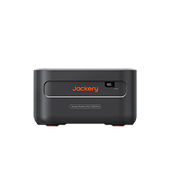
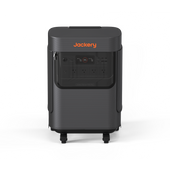
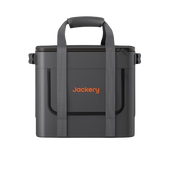
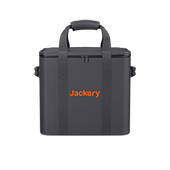
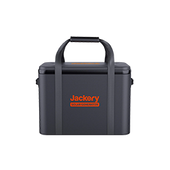
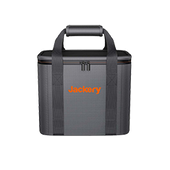
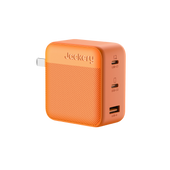
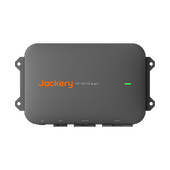
![[Add-on] Jackery Manual Transfer Switch for Explorer 5000 Plus](http://ca.jackery.com/cdn/shop/files/add-on-jackery-manual-transfer-switch-for-5000-plus-240V.webp?v=1757043692&width=170)
